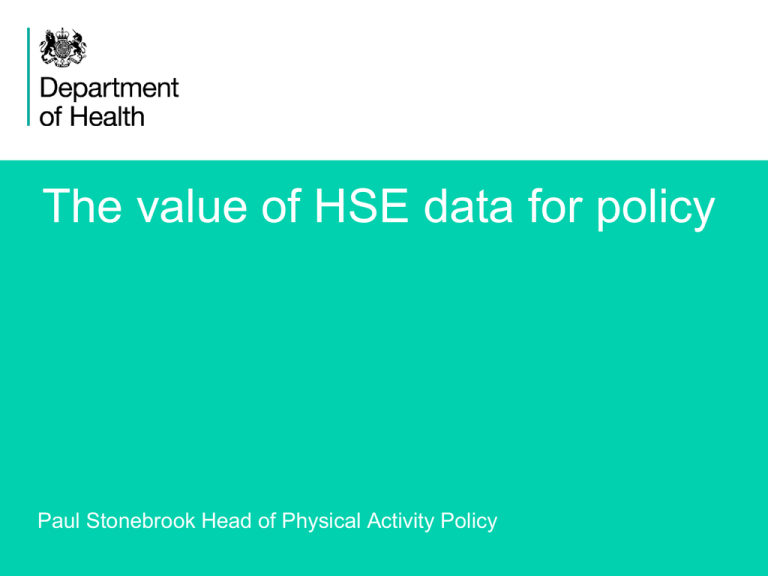The value of HSE data for policy 1
advertisement

The value of HSE data for policy Paul Stonebrook Head of Physical Activity Policy 1 I am going to concentrate on the following areas: • • • • • • • 2 History of Physical Activity in HSE Context and how HSE adds value Policy questions that HSE can answer Accommodating new guidelines How policy fits into the new public health system DH policy priorities Ambitions for future data collection Physical activity has been measured through HSE since 1991 3 Year Title 2004 Health of Minority Ethnic Groups 2005 Health of Older People (2007) (Attitudes and knowledge) 2008 Physical Activity and Fitness 2012 Health, Social Care and Lifestyles HSE provides a unique resource: • A public health survey (measures PA in the context of other behaviours and conditions) • Measures all forms of physical activity (including occupational) • Face to face questionnaire • Validated • Perceived as the ‘Gold Standard’ But: • Does not provide a sufficient sample size to measure physical activity at a local level 4 We have established a PHOF indicator for physical activity: Domain 2: Health Improvement Outcome Indicator: • 2.13i Proportion of adults achieving at least 150 minutes of physical activity per week in accordance with UK CMO recommended guidelines on physical activity • 2.13ii Proportion of adults classified as ‘inactive’ Data Source: Sport England’s Active People Survey 5 We look to HSE to help answer a range of questions to support policy: • What is the current trend in physical activity levels for adults and children? • What is contributing to any change? • The relative popularity of different activities? • Patterns of activity and inactivity across demographic groups and the life-course? • Regional variations? • What is the state of the nation’s health? • How should government intervene? For whom and what sort of activity should we be promoting? • What are the associations with obesity, etc.? 6 What would be the impact of switching to the new UK CMOs’ PA guidelines? • What proportion of adults met the new 150min guideline in 2012? • What proportion of adults participated in musclestrengthening activities? • What proportion of older adults participated in exercise to improve balance / co-ordination? • What proportion of children aged 2-4 meet the new guidelines for under 5s of at least three hours of physical activity per day? 7 We found close agreement between HSE, APS and US data for 150min in adults: Survey Prevalence HSE 67% of men and 55% of women Active People Survey 61% of men and 51% of women US data* 64.5% (HSE data showed similar proportions of men and women meeting the recommendations in 2008 and 2012) *State Indicator Report on Physical Activity, 2010 8 From April 2013 Public Health England assumed responsibility for local delivery of physical activity 9 Department of Health Public Health England • • • • • • • • • • Policy Stewardship Moving More, Living More Responsibility Deal Grants to Walking Cities Briefing Ministers Delivery Evidence base Surveys (but not HSE) PA Implementation Framework We are starting to identify future priorities for data collection • Coherent approach to physical data collection and reporting • Annual reporting at national and local levels • More use of objective measures • Greater use of fitness testing • Local measure of physical activity in children and young people • Standardised measurement of physical activity across the UK, with a view to WHO investigation of a global measure (See report of All Party Commission on Physical Activity) 10


